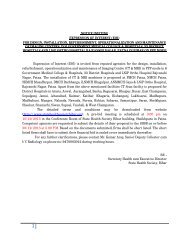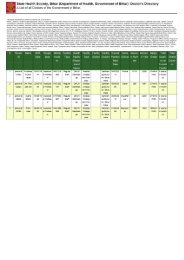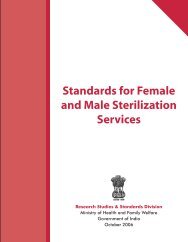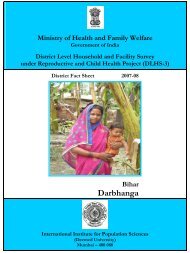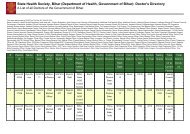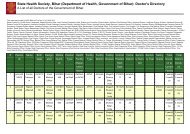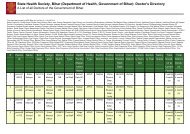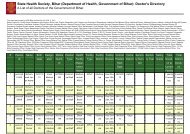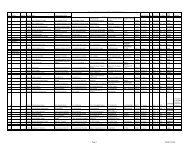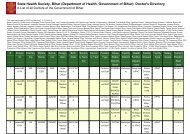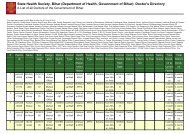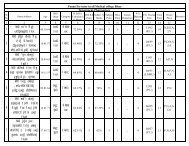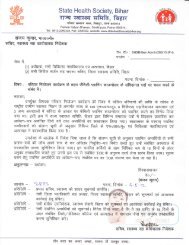District Health Action Plan - STATE HEALTH SOCIETY-----BIHAR
District Health Action Plan - STATE HEALTH SOCIETY-----BIHAR
District Health Action Plan - STATE HEALTH SOCIETY-----BIHAR
Create successful ePaper yourself
Turn your PDF publications into a flip-book with our unique Google optimized e-Paper software.
2-National Leprosy Elimination Programme<br />
Leprosy is a chronic infectious disease caused by M. Leprae, an acid-fast, rod shaped<br />
bacillus. The disease mainly affects the skin, the peripheral nerves, mucosa of the upper<br />
respiratory tract and also the eyes, apart from some other structures. Leprosy has afflicted<br />
humanity since time immemorial. It once affected every continent and it has left behind a<br />
terrifying history and human memory of mutilation, rejection and exclusion from society.<br />
The Govt. of India started the National Leprosy Elimination Programme in 1983 and Multi-<br />
Drug Therapy (MDT) was introduced in a phased manner district by district. The Prevalence<br />
Rate of leprosy (PR) was 21.1 in the year March-1985 which has come down to 0.89 by June-<br />
2006. World Bank assisted National Leprosy Elimination Programme (NLEP) phase-2 has<br />
been initiated since 2001.The goal of NLEP phase-2 was to eliminate leprosy by March-2005<br />
by reducing the prevalence rate of leprosy to below 1 per 10,000 populations. The strategy of<br />
the 2nd phase of NLEP was to detect leprosy patients from high endemic districts and urban<br />
slums through Special <strong>Action</strong> <strong>Plan</strong> for Elimination of Leprosy (SAPEL).<br />
According to the community, leprosy is a hereditary skin disease. It is believed to be curse of<br />
God. The patient is secluded from society. Initially individuals hide the symptoms because of<br />
fear of isolation from the society. There is a general notion that the disease spreads by touch.<br />
Very few are aware that the disease is curable or have heard about MDT. Prevailing<br />
erroneous beliefs and lack of awareness have been identified as the main factors which hinder<br />
the progression of the eradication programme.<br />
Skin disease Misconceptions<br />
Spreads by touch<br />
Secluded from<br />
society<br />
To lower the burden of leprosy and to eliminate it from the list of public health problems the<br />
programme (NLEP) aims at providing quality leprosy services through the general health care<br />
system. To strengthen the programme more effectively following strategies have been<br />
suggested.<br />
PRIORITY AREAS:<br />
Hereditary<br />
� Regular programme review with<br />
special reference to high and<br />
medium priority blocks and PHCs<br />
� Strategic plan for High Priority<br />
Blocks<br />
Curse of God<br />
Hide because of<br />
fear of isolation<br />
Unaware of<br />
treatment<br />
� Supervision & monitoring of<br />
NLEP indicators monthly by all<br />
BHOs<br />
� Active surveillance at regular<br />
interval<br />
� Strengthening the already existing<br />
Integration of NLEP with GHS<br />
55 | P a g e D i s t r i c t H e a l t h A c t i o n P l a n 2 0 1 2 - 1 3 D H S , S a r a n



